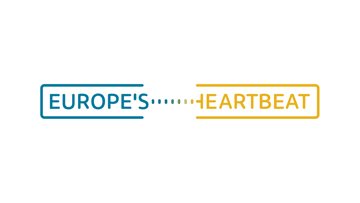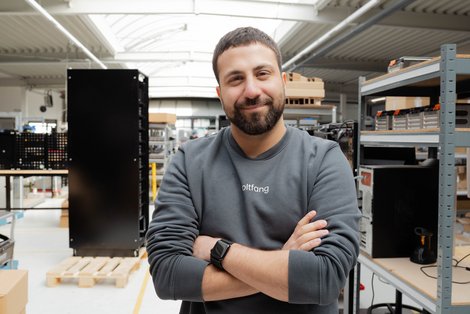Voltfang is a pioneer in the field of battery recycling management based in Aachen. Founded in 2020 as a spin-off of RWTH Aachen University, the company has developed an innovative solution for converting used batteries from electric cars into high-performance energy storage systems. These stationary storage systems can be connected to solar installations, heat pumps or charging stations directly at the customer's premises, helping to reduce the burden on the power grid and use renewable energy more efficiently. Another benefit is the direct recycling of scarce and valuable resources.
In an interview with NRW.Global Business, David Oudsandji, one of the three founders of Voltfang, gives an insight into the history of the company and the recycling process. He also explains the technology's role in the energy transition and security of supply. Oudsandji also discusses the advantages of NRW as a location for technology-oriented startups and outlines Voltfang's goals for the coming years.
- Voltfang specializes in the recycling of electric vehicle batteries. Why is this topic important and what contribution does it make today and for the future?
This topic is important for two reasons. First, energy storage is part of the energy transition. If we want to achieve the energy transition, i.e. produce green electricity and then use it, for example, to power electric vehicles, then renewable energy must be available at all times. But that is not the case. Our grid is not set up for it, and it would take far too long. That's why we need to decentralize the grid. What I mean by that is that we need to take the biggest consumers off the grid as much as possible and supply them as independently as possible. Energy storage is therefore extremely important in order to avoid overloading the grid and still be able to supply the largest consumers. Without them, we will not be able to close the gap between consumption and generation. The second point is electromobility and the circular economy, especially for batteries. There are hardly any, and recycling is not yet efficient enough. In addition, after the first life in a vehicle, there is still a lot of capacity in the batteries that can be used as storage. In this way, we also avoid using new resources such as cobalt or rare earths for our purposes. These are known to be mined under inhumane conditions in sometimes autocratic countries, on which we should not become dependent. Looking further ahead, we are also concerned about security of supply in Europe.
- In brief: How does your process work?
First, we receive our batteries directly from vehicle manufacturers or fleet owners, such as bus companies, which we then test and integrate into our system. The individual modules are then assembled into units using the plug-in system. The next step is to equip them with our energy management software, which controls the flow of energy, and an inverter. We then install the units at the customer's premises and connect them to a solar installation, a heat pump, or a charging station. In short, we turn batteries into a stationary, turnkey system with customizable capacity that stores energy directly at the customer's site and makes it available on demand. At the end of the day, it's a simple idea, but one that is complex to implement.
- What was your inspiration and your vision when you founded the company?
The company was founded almost by accident. We three founders own an older camper that had a rooftop solar system, but the battery kept dying. When the camper needed a new battery, we immediately looked for a battery alternative. We found Tesla batteries. That worked, but the batteries were way too heavy, so we put the project on hold. However, we were able to take the idea further in the workshop of a family member of one of the founding members who wanted to install a storage system there. We built it and then, at the end of our studies, we were faced with the question of what we wanted to do: Work in a company, or use our knowledge from RWTH Aachen University to do something on our own that would have a meaningful impact on society? In the end, we decided to go for the latter – that was our shared vision. One thing led to another, and we gradually built up Voltfang. From the first investor, to the first customer, to the first employees, to where we are today. Today we have about 80 employees and serve some well-known customers such as Aldi.
- What makes NRW an attractive location for a tech startup like Voltfang, and what advantages does it offer founders who focus on technological innovation?
The two biggest arguments in favor of NRW as a location are the strong university and research landscape and the high population and company density, which gives us a large number of potential customers. But there are also things that are missing, such as continuous funding and support beyond the startup phase. Ideas, startups and initial prototypes are really strong and very well supported here, for example by the Regional Economic Development Program, the EXIST startup grant or the NRW startup grant. This helps a lot in the beginning, but in the growth phase, towards a profitable and scalable business model, i.e. the scale-up, there are limits. This is especially unfortunate because NRW has so much potential thanks to its numerous universities, research institutions, large population and the will to create. If you want to have and retain local industry, you sometimes need more support than your competitors abroad, who are fully subsidized. In our view, we need to step up our game here and invest more boldly. Especially in relevant areas such as the battery industry, electromobility, semiconductors, artificial intelligence, quantum computing, and so on. These industries must be kept in Germany and NRW, otherwise we will become dependent in a way that nobody can want.
- Where do you see the company in five years' time?
We still have a lot on our to-do list, and above all, we want to keep growing. The energy transition needs electricity storage. The cheaper and more we can produce, the more we can contribute to the transition. We have everything we need, now it's time to get down to business. We will continue to produce in Aachen and the surrounding area, but in the short to medium term we will also be looking around in the USA. We are already expanding our customer network beyond national borders. We have customers in Austria and will soon have customers in the Netherlands, Belgium, Spain and Italy. One specific goal is to have a capacity of 2.1 gigawatts on the grid by 2030, which is exactly the capacity of the Weisweiler power plant that will be shut down by then. That would be a nice transition that will make us all very happy.
- Mr. Oudsandji, thank you very much for speaking with us!


